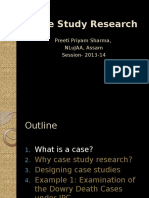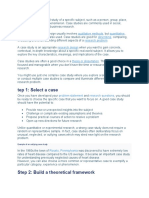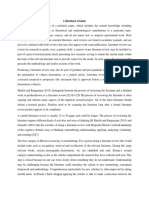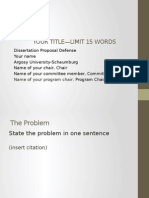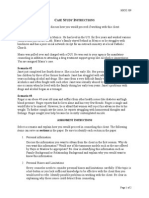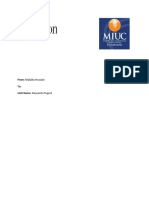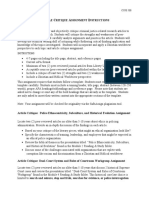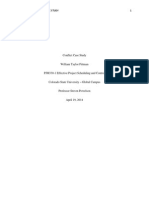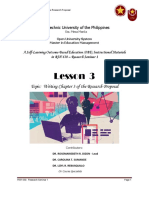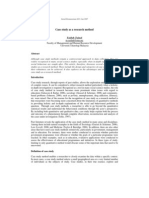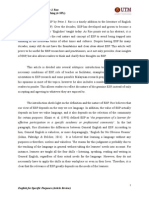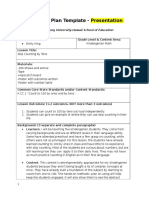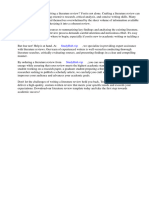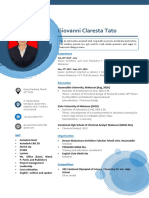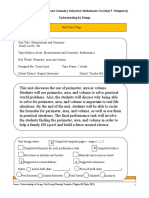1.0 2.
Definition of Case Study Different Types of Case Studies
In general, there are three main types of case studies: descriptive, explanatory, and exploratory. (Tellis, 1997 cited in Yin, 1993) In descriptive case studies, the researcher will produce detailed descriptions of the whole process. It is something similar to narrating someones story. Usually a researcher will describe their findings through different perspectives. They will imagine the whole real scenario that has been observed or events that have been described by the research subjects and put them into words. The written form of their descriptions is called a depiction. According to Gall, Gall and Borg (2003), researchers who make thick description of the events described, where they are able to reconstruct the situation as much as they can, will be able to create a good depiction. In addition, before conducting descriptive case studies, researchers will have to develop a descriptive theory (Tellis, 1997). The information
gathered from the research subjects will then be compared to the descriptive theory. The next type of case study is the explanatory case studies. As its name suggests,
explanatory case studies are done to explain some phenomenon. In fact, this type of case study is suitable to do causal investigations, which is to investigate the causes and effects of a particular phenomenon. For example, a researcher may want to investigate the factors that lead to the success of a particular student in his academic results. Likewise, he can also identify the effects of a students academic performance using group discussions to study. Gall, Gall and Borg (2003) refer to the explanations made as patterns. These patterns can be divided into two, which are the relational patterns and the causal patterns. If the variables do not affect each other in either way, it will be a relational pattern. If there are causes and effects in the study, it will be a causal pattern. Lastly, the exploratory case studies. Researchers often use this kind of case study to collect more data from the research subjects to produce a more in-depth research. For instance, a researcher may want to conduct an exploratory case study on a particular student to observe his reading skills. While the researcher is observing, many questions will surface: What methods or strategies does this student use to improve his reading skills? Are these skills suitable or appropriate? These questions will lead the research to conduct a more-detailed research to gather more information about the reading process of the student. In fact, this
�type of case study is done before the researchers develop their research questions and hypotheses. Apart from these three types of case studies, Cherry (n.d.) also mentioned two more types: Collective case studies and instrumental case studies. Collective case studies involve
studying a group of individuals. On the other hand, instrumental case studies only occur when researchers are able to understand more about the individual or the group than other observers.
3.0
Sources of Information in Case Study
There are numerous different sources of evidence in case study that researchers can exploit to collect information for their research. Yin (1994) and Stake (1995) identified six major sources of information which are documents, archival records, interviews, direct observations, participant-observations and physical artifacts. According to Tellis (1997), documents are useful for making inferences and they serve to corroborate the evidence from other sources. Examples of documents are letters, memoranda, newspapers, articles, letters and et cetera (Tellis, 1997). However, if an inexperienced researcher is not able to manage the documents properly, the documents might direct the researchers to a wrong direction. The second source of evidence is the archival records. Some examples of archival records are survey records, name lists, service records, survey data and others (Tellis, 1997). Researchers have to be very cautious when evaluating the accuracy of the records before exploiting data from them. Tellis (1997) agrees by saying that, even if the records are quantitative, they might still not be accurate. Next are interviews. Interviews are the utmost important sources of information in case study. Open-ended, focused, structured survey-type questions are some examples of interviews (Tellis, 1997 and Cherry, n.d). Open-ended interview requires the interviewee to give comments or suggest some solution about the subject whereas focused interview require the interviewee to answer a set question within a short period of time (Tellis, 1997). Moreover, researchers who use this type of evidence must not depend on one informant but search the same data from other sources to verify its authenticity (Tellis, 1997).
�Direct observations are most widely used in case studies. As suggested by its name, researchers collect data through observing individuals in a natural setting. (Cherry, n.d.) Certain activities and behaviours are able to be recorded by the researchers when they observe the research participants directly. Besides, direct observations are effective to provide additional information about the study topic. The reliability of this observation will increase when the number of observers increases. (Tellis, 1997) Unlike direct observations, participant-observations include the researcher as the participant in the study. As stated by Tellis (1997), participant-observations are usually used in conducting case studies among groups of people or even neighbourhood. This method is used when researchers need to collect unusual occurring data among the group members. However, there is a shortcoming for this observation, where researchers might alter the course of events while they are playing the active participant role (Tellis, 1997). This may affect the results of the study. Lastly, the physical artifacts. Physical artifacts can be anything that is collected during the study, for instance, tools or instruments. These artifacts serve as a physical evidence to aid the researchers in their findings, where researchers are able to gather more information about an individual or a group. In fact, Tellis (1997) mentioned that discovering physical artifacts can widen researchers perspective. Although there are many types of sources of evidence in case study, researchers should be aware of the suitability of the sources to different types of case studies. They should remember that not all sources are relevant for all kinds of case studies. (Tellis, 1997, cited in Yin, 1994) Therefore, before conducting any kind of case studies, researchers should always first select the best source for the case study they wish to conduct to gain the best results possible.
4.0
Case Study Design
�5.0
Case Study Methods
Tellis (1997, cited in Yin, 1994) listed four stages in conducting a case study. Firstly, design the case study. In this stage, researchers will have to decide which type of case study they would like to conduct. For instance, some researchers may want to conduct a descriptive case study, and some on an explanatory case study. Besides, researchers should also decide on how many case studies they want to carry out for their research. Some may want do single case design to prove or criticise a theory, or even to investigate an extreme case. (Tellis, 1997, cited in Yin, 1994) Multiple case designs will provide researchers more information on a certain fact or theory, as they gather information from a lot of different sources. It will aid the researchers to draw conclusions based on the information gained. Secondly, conduct the case study. In this stage, researchers should prepare to collect data, distribute questionnaires and conduct interviews. Tellis (1997, cited in Yin, 1994) stated three principles of data collection in case studies: use multiple sources of data, create a case study database, and maintain a chain of evidence. Through using multiple sources of data and maintain chain of evidence, we can increase the reliability of the results gained from case studies. Besides, researchers can keep their work organised if they use case study database to store all their findings. Next, when researchers have gathered all the data needed, they will need to analyse the evidence. In this stage, researchers should be aware of different analysing techniques that can be used in their research. For instance, for the questionnaires, they can analyse them quantitatively or qualitatively based on the nature of the questions and research done. Quantitative data should be tabulated into charts or graphs and qualitative data can be represented in table forms. According to Tellis (1997), high quality analysis consists of showing all relevant evidence and rival explanations were used, the analysis made shows the significance of the case study and researchers use their knowledge and experience fully in the case study. Last but not least, develop the conclusions, recommendations and implications. After
analysing the data, researchers should be able to draw conclusions based on their findings. In this stage, clear explanations are vital to make readers understand the findings of the research. Tellis (1997) stated that researchers should use clear explanations instead of technical jargons in this stage.
�6.0
Techniques for Organizing and Conducting Case Study
Figure 6.1 shows the techniques required to conduct a case study. According to Soy (1997), there are six steps to a successfully technique for organizing and conducting case study. The first step is to determine and define the research questions. Researchers who use case study as a research method need to determine the research focus by creating research questions and the purpose of the study. As Soy (1997) points out that, case study research usually answer questions which begin with how or why and it is restricted to an events or conditions. Through research questions, researchers are able to decide on the method for the study. Second step is to select the cases and determine data gathering and analysis techniques. In this phase, Soy (1997) explains that, the researchers need to determine which approaches best used to select the case (single or multiple real-life cases) and determine what data gathering and analysis techniques approaches to use. In the process of selecting the cases, researchers can look back what the purpose of the study is so that they have an idea when searching for evidence. Furthermore, researchers need to use the data gathering tools systematically when collecting evidence which normally involve qualitative and quantitative. (Soy, 1997). Soy (1997) stated that to ensure the validity of case studies, cross-case examination and withincase examination techniques can be used. Third, prepare to collect the data. Case studies research produces a massive amount of data. Hence, it is crucial to organized all the data systematically to avoid chaos and confusion beforehand. Moreover, researchers can make use of databases when categorizing, sorting, storing and retrieving data for analysis. (Soy, 1997). Then, pilot test is being conducted using data gathering method to identify and correct the problems. Fourth, collect data in the field. Soy (1997) mentions that, observation on the object of the case study are being carried out to identify casual factors related to the observed phenomenon. Case study research is not rigid whereby researchers could add questions during interviews or discuss with the object of the study several times. However, all changes have to be documented systematically. In this phase, biases might occur due to close relationship with the respondent. Therefore, researchers need to manage the issue and evidence thoroughly. Fifth, evaluate and analyze the data to discover the relation between the research object and outcomes. According to Soy (1997), this phase provide the opportunity for researchers to triangulate data to strengthen the research findings and conclusions. Some techniques that can
�be applied to evaluate and analyze the data are categorizing, tabulating, creating flow charts, placing information into arrays and conduct cross-check of facts. (Soy, 1997). Lastly, prepare the report. Case study report presents the data openly where people can easily search for it and enable them to apply the experience in his or her own life (Soy, 1997). There are several techniques for composing the report which include handling the case as a separate chapter, treat the case as a chronological recounting or report the case study as a story (Soy, 1997). In the process of writing the report, researchers can look for people such as journalist to review and give comment on the draft report and continue to write the report taking into consideration the comments given (Soy, 1997).
7.0 8.0
Case Study in Teaching Advantages and Disadvantages of Case Study 8.1 Advantages of Case Study as a Research Method
Case study as a research method has numerous advantages. One of the advantages of case study is that the data is not examined outside from the context but it is carefully examined within the situation where the activity takes place (Zaidah, 2007). For example, a researcher who wants to investigate how a learner applies the reading strategies, the researcher will have to examine the subject within the learners environment such as reading in the classroom or reading for leisure. As compared to other methods such as experiments, it would segregate the phenomenon from its context whereby it focuses only on a limited number of variables (Zaidah, 2007). Last but not least, qualitative method used in case studies help to examine and explain the data in real-life environment which according to Zaidah (2007), it may not be capture through experimental or survey research. For example, a case study on reading strategies provides the quantitative information regarding the strategies. Not only that, it also describe the reason and how the strategies are being used. As the respondents use higher order thinking skills in reading, all the strategies involved must be explored in relation to others strategies not in isolation. 8.2 Disadvantages of Case Study as a Research Method
�Despite all the advantages discussed, there are some disadvantages of case study. First, lack of strictness in case studies. Many researchers of case studies are careless whereby the data described are ambiguous and they include biased views to manipulate the facts. Consequently, it creates problems in constructing validity due to potential researchers subjectivity (Tellis, 1997). In addition, case studies provide insufficient source for scientific generalization because it used a small number of subject and some with only one subject (Zaidah, 2007). Furthermore, Yin (1984) says that, case studies are difficult to conduct, takes a very long time and produces a massive amount of documentation. Problems arise when the huge numbers of data are not organized systematically. Besides that, many researchers encounter problems when it comes to generalizing conclusion because case studies depend on a single case exploration. (Tellis, 1997).



